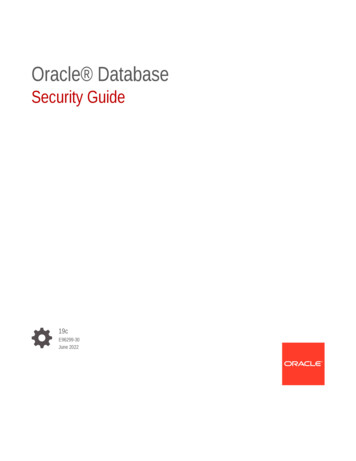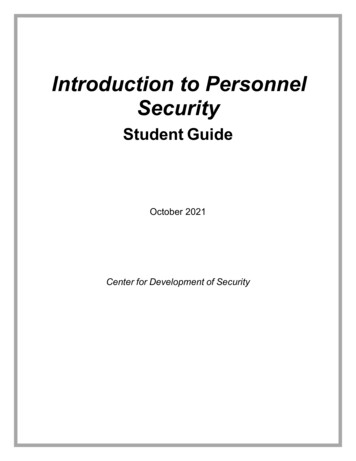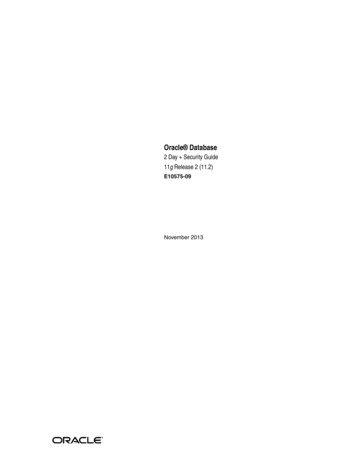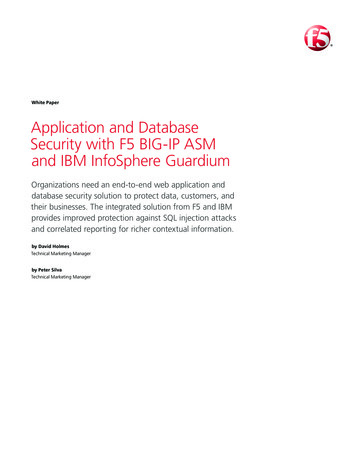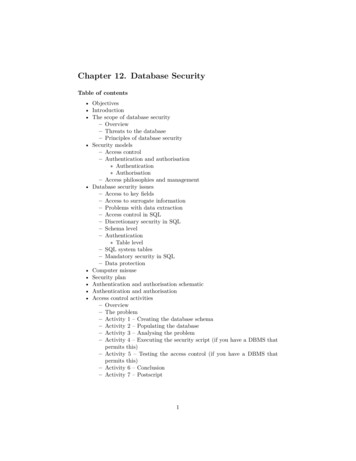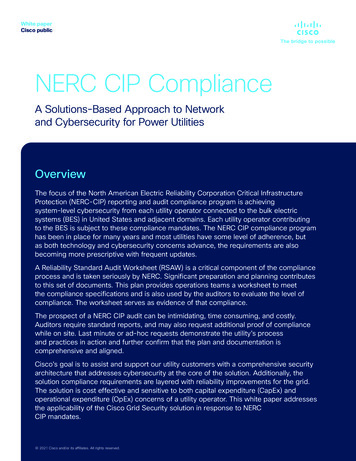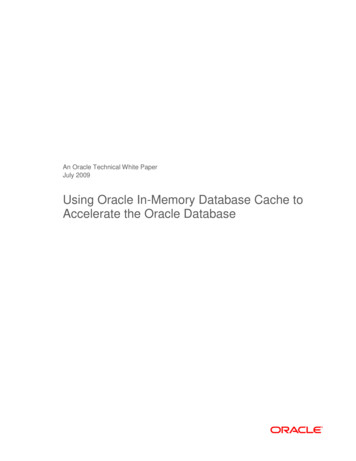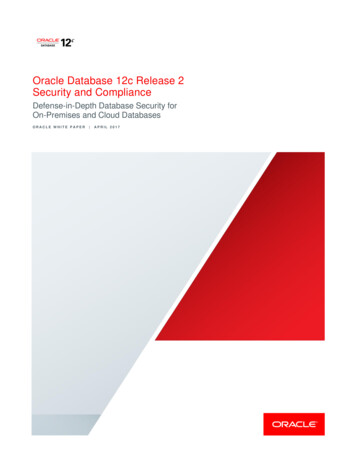
Transcription
Oracle Database 12c Release 2Security and ComplianceDefense-in-Depth Database Security forOn-Premises and Cloud DatabasesORACLE WHITE PAPER APRIL 2017
Table of ContentsIntroduction1Oracle Database 12c Security2Evaluating Security Risks2Knowing Where Sensitive Data Resides with Sensitive Data Discovery3Reducing the Attack Surface with Role and Privilege Analysis3Evaluating the Database Security Posture with Database Security Assessment4Monitoring the Database Configurations with Enterprise Manager5Preventing Unauthorized Access to Data6Preventing Database Bypass with Transparent Data Encryption6Scaling Transparent Data Encryption with Oracle Key Vault7Limiting Privileged User Access with Database Vault7Protecting sensitive data in applications with data redaction9Minimizing sensitive data exposure with data sub setting and maskingDetecting Access Attempts and Abuse1011Auditing Database Activity with Universal and Conditional Audit11Managing Audit Data with Audit Vault11Monitoring SQL Activity with Database Firewall12Protecting Application Data with Data-Driven Security13Implementing Fine-Grained security with Virtual Private database13Enforcing Application Data Controls with Real Application Security14ConclusionORACLE DATABASE 12C RELEASE 2 SECURITY AND COMPLIANCE16
IntroductionThe need to secure data is driven by an expanding privacy and regulatory environment coupled withan increasingly dangerous world of hackers, insider threats, organized crime, and other groups intenton stealing valuable data. The security picture is complicated even more by the rapid expansion ofaccess to sensitive data via the Internet, an unprecedented understanding of technology, increasingeconomic competition, and the push to achieve greater efficiencies through consolidation and cloudcomputing. Information targeted for attack has included citizen data, intellectual property, credit carddata, financial information, government data, and competitive bids. Attack methodologies includehacking of privileged user accounts, exploitation of application vulnerabilities, media theft, and othersophisticated attacks collectively known as advanced persistent threats or APT. In response to theincreasing threat to data, regulations have been put in place that include the numerous U.S. Stateprivacy laws, Payment Card Industry Data Security Standard (PCI-DSS), the U.K Data Protection Act,the European Union’s General Data Protection Regulation (GDPR), and the Korean Act on Protectionof Personal Data, to name a few.To better understand the importance of database security one needs to consider the potential sourcesof vulnerability.» Threats that target the operating system can circumvent the database by accessing raw data files,bypassing application security, access controls inside the database, network security, and encrypteddrives.» Proliferation of production data beyond the controls of the production environment expand the scopeof compliance and increase the risk to data.» Privacy related information can be exposed to individuals without a true need-to-know due to anoversight in the development process or the complexity of modifying legacy applications.» Privileged user accounts and over privileged applications may become targets for highly specializedattacks or the source of insider threats.» Ad-hoc access to application data by privileged accounts may violate internal policies, regulatorymandates, service level agreements, as well as expose data to external attacks.» Application bypass through SQL injection can expose large amounts of sensitive data to attackers orunauthorized users.» Configuration drift or changes that create deviation from internal deployment standards and securitybest practices can result in audit findings, impact business continuity, and increase security risks.1 ORACLE DATABASE 12C RELEASE 2 SECURITY AND COMPLIANCE
Oracle Database 12c SecuritySecurity and compliance requires a defense-in-depth, multi-layered, security model that includes preventive,detective, and administrative controls. Controls should be aligned with the sensitivity of the data, its location, itsenvironment, and applicable regulations. Additional consideration should be given to the business impact shouldthe data be lost, stolen, or used for unauthorized purposes. Oracle Database 12c Release 2 (12.2), the latestgeneration of the world’s most popular database, is available for deployment on premises and in the Oracle Cloud.With Oracle Database 12c Release 2, Oracle continues to lead the industry with the most complete solution set forsecuring business-critical data throughout the data lifecycle.Oracle Database 12c security, combined with the Oracle Audit Vault and Database Firewall and Oracle Key Vaultsolutions, provide unprecedented capabilities to protect data and defend against cyber threats. Deploying andmanaging Oracle Database 12c security is easy with simplified setup and configuration as well as a new securitymenu in Oracle Enterprise Manager 12c. Oracle Database 12c introduces a wealth of security enhancements andnew features including conditional auditing, privilege analysis, data redaction, enhanced encryption keymanagement, real application security, mandatory realms, and performance optimizations to name a few. Fullyintegrated with Oracle Multitenant, security controls can be customized for individual pluggable databases.Oracle Database 12c security enables four pillars of security controls to meet the need for a multilayered defense-indepth data security strategy. These pillars enable customers to» Evaluate the security posture and potential risks to their applications» Prevent on authorized access to data» Detect the various activities which can be indicative of data breach» Leverage Data-Driven Security to secure data at the sourceThe remainder of this paper will examine the Oracle Database 12c features which enable these security pillars fordata security.Figure 1. Security controls available for Oracle Databases can be organized into four pillars.Evaluating Security RisksTo implement a database security strategy, you first need a thorough understanding of the risks associated with thedata assets in your organization. Factors which influence these risks include:» Sensitivity of the data under management in various databases» Threats to the data from a variety of potential sources2 ORACLE DATABASE 12C RELEASE 2 SECURITY AND COMPLIANCE
» Possible vulnerabilities to databases due to improper deployment, configuration, user rights administration ormaintenanceFeatures in the “Evaluate” pillar enable administrators to implement a risk-based approach to security. These kindsof controls can catch security miss configurations, inadvertent privilege escalations, and potential misuse by overprivileged accounts.Knowing Where Sensitive Data Resides with Sensitive Data DiscoveryKnowing where your sensitive data resides is an important first step in deploying a defense-in-depth security model.Identifying sensitive databases based on the types of applications they support is a common method used to classifydatabases. However, it is also valuable to understand the level of sensitivity of the data under management invarious applications. Knowing where specific types of data reside can be challenging due to the complexity and sizeof large applications.Oracle Enterprise Manager Data Discovery and Modeling and Sensitive Data Discovery (SDD) can be used toautomate the process of locating sensitive data within an application schema. This information can provideorganizations with a better understanding of which data assets require higher levels of security controls. In addition,the results from an SDD analysis can be used with Oracle Data Masking and Subsetting and other databasesecurity solutions to identify and protect sensitive data.Oracle has created Application Accelerators for Oracle Fusion Applications and Oracle E-Business Suite to reducethe time it takes to implement data masking solutions. Application Accelerators list the sensitive data for each of theapplications. Oracle Data Masking and Subsetting uses the Application Accelerators to facilitate masking of datafrom production databases to test and development environments. In addition, the new Oracle Database 12c featureTransparent Sensitive Data Protection (TSDP) can leverage information from Oracle Enterprise Manager DataDiscovery and Modeling to apply security controls such as Oracle Advanced Security Data Redaction.Reducing the Attack Surface with Role and Privilege AnalysisOver privileged user accounts is a common vulnerability that hackers can seek to exploit. To prevent this,implementers should apply a least privilege model to all user accounts, providing users with only the rights theyrequire to run their applications and get their jobs done. One challenge with applying this principle to databaseapplications, however, is in understanding exactly which rights are required by complex enterprise applications. Asa result, implementers often default to granting broad data access rights to application users.Oracle Database Vault with Oracle Database 12c introduces the capability to perform user privilege analysis. OracleDatabase Vault privilege analysis helps increase the security of applications by identifying the actual privileges inuse by a database user at run-time. Privileges identified as unused can be evaluated for potential revocation,helping reduce the attack surface and achieve a least privilege model. Privilege analysis can be integrated into theapplication development process, helping create more secure applications. It can also be used to analyzeentitlement requirements for common database administration tasks.3 ORACLE DATABASE 12C RELEASE 2 SECURITY AND COMPLIANCE
Figure 2. Oracle Database Vault privilege analysis identifies the privilegesrequired by database users at run-time.Oracle Database Vault with Oracle Database 12c comes pre-installed by default and can be easily enabled. Inaddition, Oracle Database Vault administration is fully integrated with Oracle Enterprise Manager Cloud Control,providing Security Administrators with streamlined and centralized management across their hybrid clouddatacenter.Evaluating the Database Security Posture with Database Security AssessmentIn order to provide a secure repository for data, databases must be deployed and configured appropriately.Database vulnerabilities can arise from misconfigured or inactive user account, unencrypted data, insufficientaccess controls, lack of audit policies and incorrect OS-level file permissions to name a few. These risks arecompounded in environments that implement replication for high-availability, consolidate data from a variety ofapplications into a single database, or support legacy applications.The Oracle Database Security Assessment Tool (DBSAT) is an application which automatically checks a number ofdatabase configurations. These include information regarding user accounts privileges and roles, authorizationcontrols, data encryption, fine-grained access control, auditing policy, database configuration, listener configuration,and OS file permissions. DBSAT incorporates 71 security rules in total spanning various aspects of databaseconfiguration. The tool runs against the Oracle database and collects information regarding configurations into aconfiguration file. The DBSAT reporter then generates a report for analysts and administrators summarizing anumber of security findings. The output from DBSAT includes a summary of scores for each of the rules, as well asan indication of the relative degree of risk found with the configuration as well as suggestions for areas whereconfiguration security can be improved.4 ORACLE DATABASE 12C RELEASE 2 SECURITY AND COMPLIANCE
HTMLDBSAT CollectorDBSAT ReporterSpreadsheet10g, 11g, 12cTextFigure 3. The Database Security Assessment Tool (DBSAT) incorporates a collector which gathersfindings, as well as a reporter which presents the findings to the user.Monitoring the Database Configurations with Enterprise ManagerPreventing and detecting configuration drift increases business continuity, high availability, and security. OracleEnterprise Manager Database Lifecycle Management Pack can be used to scan databases for numerous securityrelated settings, including checks for account default passwords, account status, and account profiles. Over 100 outof-the-box policy checks can be easily run against existing databases. In addition, custom configuration checks canbe defined to supplement those provided by Oracle.Figure 4. Oracle Enterprise Manager Security Configuration Reports can help compliance reporting and maintain database securityhygiene.5 ORACLE DATABASE 12C RELEASE 2 SECURITY AND COMPLIANCE
Preventing Unauthorized Access to DataAs part of the evaluation phase, customers have identified sensitive data. Now customers need to apply securitycontrols to prevent damage to databases from attacks.The prevent pillar aims to prevent the loss of data even in the event of an attack or breach. Many of the potentialthreats mitigated by the prevent pillar include OS level attacks and temp files, misuse of stolen privileged accounts,risks of data support exposure to customer service, support and other users, potential threats against test,development, and staging systems and risk of exposure of data to development or test.Preventing Database Bypass with Transparent Data EncryptionDatabase bypass threats target operating system files and backup media. Targeting these locations simplifies thejob of the attacker. No database access is required, fewer audit records, if any, are generated, and any associateddatabase as well application access controls are completely bypassed. One of the most widely used technologiesused to protect against database bypass threats is encryption. A key driver in the widespread recognition ofencryption technologies came in 2003 with the passage of California Senate Bill 1386 (SB1386). SB1386 introducedthe topic of encryption to a broad audience by including a provision that removed the notification requirement if thebreached data was encrypted. Today the need to protect privacy-related information is a global issue as companiesexpand their operations and businesses. In addition to privacy laws, the payment card industry data securitystandard (PCI-DSS), first introduced in 2006, has raised awareness across the board for security and the need torender cardholder data unreadable where it is stored and transmitted.While encryption of backup media and proper disposal of media are probably the two most well understood securitycontrols, increasingly sophisticated attacks have focused on attacking the servers themselves and gaining access tothe raw data files that hold sensitive information. Oracle Advanced Security with Oracle Database 12c deliversindustry leading encryption with transparent data encryption (TDE) and data redaction capabilities, vital to protectingsensitive application data. TDE helps prevent unauthorized access to sensitive information via direct access to theoperating system, backup media, or database exports. Sensitive data such as credit card information or socialsecurity numbers can be automatically encrypted in storage.TDE safeguards sensitive data against unauthorized access from outside of the database environment byencrypting data at rest. It prevents privileged and unauthorized operating system users from directly accessingsensitive information in database files. TDE also protects against theft, loss, or improper decommissioning ofdatabase storage media and backups.Figure 5. Oracle Advanced Security Transparent Data Encryption (TDE) prevents data lossthrough application bypass and provides data confidentially control throughout the data lifecycle.6 ORACLE DATABASE 12C RELEASE 2 SECURITY AND COMPLIANCE
The solution is transparent to applications because data is encrypted automatically when written to storage anddecrypted when read from storage. Access controls that are enforced at the database and application layers remainin effect. SQL queries are never altered, and no application code or configuration changes are required. Theencryption and decryption process is extremely fast because TDE leverages Oracle Database cachingoptimizations. In addition, TDE utilizes CPU-based hardware acceleration in Intel AES-NI and Oracle SPARC TSeries platforms, including Oracle Exadata and SPARC SuperCluster. TDE further benefits from Exadata SmartScans, rapidly decrypting data in parallel on multiple storage cells, and from Exadata Hybrid ColumnarCompression, reducing the total number of cryptographic operations performed.TDE provides a two-tier encryption key management architecture consisting of data encryption keys and masterencryption keys. The master keys are stored outside of the database in an Oracle Wallet. Built-in key managementfunctionality provides assisted key rotation without re-encrypting all of the data and management of keys acrosstheir lifecycle. TDE can be deployed easily and is installed by default as part of the database installation. Existingdata can be encrypted with zero downtime on production systems using Oracle Online Table Redefinition orencrypted offline during a maintenance period. Additionally, TDE works out of the box with Oracle AutomaticStorage Management.Scaling Transparent Data Encryption with Oracle Key VaultOracle Key Vault (OKV) enables customers to quickly deploy encryption and other security solutions by centrallymanaging encryption keys, Oracle wallets, Java keystores, and credential files. It is optimized for managing OracleAdvanced Security TDE master keys. The full-stack, security-hardened software appliance uses Oracle Linux andOracle Database technology for security, availability, and scalability. A browser-based management console makesit easy to administer OKV, provision server endpoints, securely manage key groups, and report on access to keys.Administrator roles can be divided into key, system, and audit management functions for separation of duties.Additional users with operation responsibilities for server endpoints can be granted access to their keys and walletsfor ease of management.Figure 6. Overview of Oracle Key VaultLimiting Privileged User Access with Database VaultA common characteristic of many cyber-attacks and data breaches has been the use of privileged user credentialsand their far-reaching access inside the database. Some of these data breaches were perpetrated by insiders, whileothers were executed by hackers. Privileged user accounts inside the database and their unimpeded 24/7 access toapplication data create prime targets for hackers and exploitation by insiders. Protecting against attacks requires adefense-in-depth approach. The depth of the security controls required will depend on the application and sensitivityof the data. For example, while privileged user controls may be vital on production systems, they most likely are7 ORACLE DATABASE 12C RELEASE 2 SECURITY AND COMPLIANCE
less applicable on test and development systems where sensitive data has been masked or swapped out withproduction “like” data. At the same time, multiple preventive controls may be applicable on highly sensitive systems,while a subset may be applicable on less sensitive systems.Oracle Database Vault SQL Command Controls allow customers to control operations inside the database,preventing unauthorized changes to production environments that may impact both the security posture andcompliance. Unauthorized changes can significantly weaken database security, result in audit findings, complianceviolations, and result in data breaches. SQL command controls allow potentially dangerous operations to beblocked altogether or allow verification checks such out-of-the-box factors such as IP address, authenticationmethod, and program name. SQL command controls can be configured for commands such as database connect,create table, truncate table, create directory, create database link, and create user, to name a few. These controlsprevent accidental configuration changes and also prevent hackers and malicious insiders from tampering withapplications.Oracle Database Vault helps prevent data breaches and increase the security of the database overall usingprivileged user controls, configuration controls, and separation of duty controls. These powerful controls can beconfigured to create a highly secure database environment, helping defend against attacks from both inside andoutside the organization and prevent unauthorized changes that may lead to audit findings or open doors to hackers.Figure 5. Oracle Database Vault Realms block access from privileged accountsOracle Database Vault realms prevent ad hoc access to application data by privileged accounts. Enforced insidethe Oracle database kernel, attempts to access realm protected data are blocked and audited. Monitoring theseDatabase Vault audit records can provide an important early indicator of potential malicious activity. OracleDatabase Vault with Oracle Database 12c introduces even more powerful controls that can be used to seal offaccess to application objects and lock down privileged granted to roles. Known as a Mandatory Realm, this powerfulsecurity capability can be used as an additional gate check prior to allowing access by both privileged as well astraditional users, including the object owner. Mandatory realms can also be used to protect sensitive informationwhen direct access to the application schema is required for maintenance operations or as a temporary lockdown inresponse to an active cyber threat. Mandatory realms, like traditional realms, can be pre-configured and enabledwith a single command by the database security administrator.Consolidation and cloud environments reduce cost but potentially expose large amounts of sensitive applicationdata to those without a true need-to-know. Oracle Database Vault controls provide increased security for theseenvironments. Oracle Database Vault provides three distinct separation of duty controls out-of-the-box for securityadministration, account management, and day-to-day database administration activities. Oracle Database Vault8 ORACLE DATABASE 12C RELEASE 2 SECURITY AND COMPLIANCE
separation of duty controls can be customized and organizations with limited resources can assign multiple OracleDatabase Vault responsibilities to the same administrator while retaining the security restrictions on access toapplication data.Protecting sensitive data in applications with data redactionLimiting the distribution of and access to sensitive data is a well understood security principle. What has changed,however, is the realization that much tighter controls can be put in place on access to sensitive data withoutadversely impacting business operations. The goal being to reduce the attack surface by stopping the unnecessaryproliferation of sensitive data beyond the boundaries of the consolidated database. The proliferation could be in theform of poorly designed applications that display sensitive data, copies of production data transferred to test anddevelopment environments, or shared with business partners. Regardless of the proliferation path, over exposure ofsensitive data makes it easier for data breaches and other access violations to take place and go undetected.Oracle Advanced Security data redaction provides selective, on-the-fly redaction of sensitive data in query resultsprior to display by applications. Redaction is the process of scrubbing out data. Imagine a paper document withcertain fields scratched out with a black marker. Oracle Advanced Security data redaction works similarly but onapplication data stored in the database. Because it is enforced inside the database, it is possible to consistentlyredact database columns across different application modules accessing the same data. Data redaction minimizeschanges to applications because it does not alter actual data in internal database buffers, caches, or storage, and itpreserves the original data type and formatting when transformed data is returned to the application. Data redactionhas no impact on database operational activities such as backup and restore, upgrade and patch, and highavailability clusters.Figure 3. Oracle Advanced Security Data RedactionUnlike historical approaches that relied on application changes and new software components, Oracle AdvancedSecurity data redaction policies are enforced directly in the database kernel. This application agnostic approachgreatly reduces the time and cost of addressing business requirements, especially important given the constantlyevolving regulatory landscape. Declarative policies can apply different data transformations such as partial, random,and full redaction. Redaction can be conditional, based on different factors that are tracked by the database orpassed to the database by applications such as user identifiers, application identifiers, or client IP addresses. Aredaction format library provides pre-configured column templates to choose from for common types of sensitiveinformation such as credit card numbers and national identification numbers. Once enabled, polices are enforced9 ORACLE DATABASE 12C RELEASE 2 SECURITY AND COMPLIANCE
immediately, even for active sessions. Oracle Advanced Security data redaction is also available on OracleDatabase 11g Release 2 (11.2.0.4). Oracle Advanced Security fully supports Oracle Multitenant option. Both TDEand data redaction remain in place when pluggable databases are moved to new multitenant container databases,and they protect pluggable databases while in transit.Minimizing sensitive data exposure with data sub setting and maskingThe need for realistic data sets for development and test environments has resulted in the proliferation of databeyond the boundaries of production applications. This movement of production data dramatically increases the riskto data and increases the overall cost of security and compliance. Masking of data before it is moved fromproduction eliminates the risk of data breaches in non-production environments by irreversibly replacing the originalsensitive data with fictitious data so that data can be safely shared with IT developers or business partners.Oracle Data Masking and Subsetting enables entire copies or subsets of application data to be extracted from thedatabase, obfuscated, and shared with partners inside and outside of the business. Most importantly, during theobfuscation process, application integrity is preserved by maintaining data relationships across application tables.Oracle Data Masking and Subsetting improves security by reducing the scope of data exposed to partnerorganizations. Compliance costs are lowered by narrowing the compliance boundary for test and developmentgroups.Figure 4. Oracle Data Masking and Subsetting PackOracle Data Masking and Subsetting provides end to end automation for provisioning test databases fromproduction in compliance with regulations. Sensitive information such as credit card or social security numbers canbe replaced and used for development and testing without expanding the security perimeter. This reduces thenumber of database systems that need to be monitored for compliance and security.Important considerations in masking include the ability to maintain referential relationships between applicationtables after the masking process has taken place. Application records that span application tables and are linked bya given column need to have those values consistently replaced across the related tables. Oracle Data Masking andSubsetting discovers these relationships and masks all related data elements automatically while preservingreferential relationships. The combination of sensitive data columns and the associated primary key-foreign keyrelationships are stored in an Application Data Model in the Oracle Enterprise Manager repository.Oracle Data Masking and Subsetting provides a centralized library with out-of-the-box mask formats for commontypes of sensitive data, such as credit card numbers, phone numbers, national identifiers (social security number forU.S., national insurance number for U.K.). By leveraging the Format Library in Data Masking, enterprises can applydata privacy rules to sensitive data across enterprise-wide databases from a single source and thus, ensureconsistent compliance with regulations. Enterprises can also extend this library with their own mask formats to meettheir specific data privacy and application requirements.10 ORACLE DATABASE 12C RELEASE 2 SECURITY AND COMPLIANCE
Once the work of associating masking definitions with application attributes is complete, the formats and dataassociations can be saved in the Application Data Model and re-executed when test, development or partners needa refresh of data. Oracle Data Masking and Subsetting Pack can support masking of data in heterogeneousdatabases, such as IBM DB2 and Microsoft SQLServer, through the use of Oracle Database Gateways.Detecting Access Attempts and AbuseSatisfying compliance regulations and reducing the risk of security breaches are among the top security challengesbusinesses face today. Traditional perimeter firewalls play an important role in protecting data centers fromunauthorized, external access, but attacks have grown increasingly sophisticated, bypassing perimeter security,taking advantage of trusted middle tiers, and even masquerading as privileged insiders. Examination of numeroussecurity incidents has shown that timely examination of audit data could have helped detect unauthorized activityearly and reduced the resulting financial impact. Various studies and surveys have concluded that a sizeablepercentage of data breaches have been perpetrated using insider credentials, typically one with elevated access tosystems and its dat
Oracle Database 12c security, combined with the Oracle Audit Vault and Database Firewall and Oracle Key Vault solutions, provide unprecedented capabilities to protect data and defend against cyber threats. Deploying and managing Oracle Database 12c security is easy with simplified setup and configuration as well as a new security
